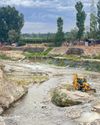
THE SECRET that drives the Earth's habitability lies some 2,000-6,000 kilometres below our feet in the core of the planet. We know that the innermost layer of the Earth is slowly turning solid, and as it does, it radiates heat that generates a magnetic field which rises to surround and protect the planet. But all our understandings on the core are based on just hypothesis; there is so much about the Earth's heart that eludes us.
In fact, the world has seen more success in space than in understanding its own planet. US space agency NASA's Voyager 1 spacecraft, launched in 1977, has travelled 23 billion km from the Earth. In contrast, the deepest hole drilled into the planet's surface is just 12.2 km (more on this later). What makes it difficult to conduct physical studies of the core is the unforgiving interiors of the Earth. Human bones could turn into dust at depths of 200 km. The base of the crust has a temperature of around 1,000°C, the bottom of the mantle is 3,000°C and the core is about 6,000°C. The pressure, too, could kill. Studies show it can range from 24-136 gigapascals (1 gigapascal or GPa is 1 billion pascals) in the lower mantle to 135-330 GPa in the outer core and 330-365 GPa in the inner core. Humans can only withstand up to a few thousand KPa (1 kilopascal or KPa is 0.012 GPa).
Therefore, any study that tries to throw some light on the functioning of the core is subject to abject scrutiny. Two such studies, published early this year, have triggered debate and discourse among scientists, while highlighting that we do not yet have the technological resources to reach the deep Earth and gain more concrete insights.
This story is from the {{IssueName}} edition of {{MagazineName}}.
Start your 7-day Magzter GOLD free trial to access thousands of curated premium stories, and 9,000+ magazines and newspapers.
Already a subscriber ? Sign In
This story is from the {{IssueName}} edition of {{MagazineName}}.
Start your 7-day Magzter GOLD free trial to access thousands of curated premium stories, and 9,000+ magazines and newspapers.
Already a subscriber? Sign In

In leading role again
MOVIES AND WEB SERIES ARE ONCE AGAIN BEING SET IN RUSTIC BACKGROUNDS, INDICATING A RECONNECT BETWEEN CINEMA AND THE COUNTRYSIDE

One Nation One Subscription comes at a huge cost
As top US universities scrap big deals with top scientific publishers, India’s ONOS scheme seems flawed and outdated

Return of Rambhog
Bid to revive and sell the aromatic indigenous paddy variety has led to substantial profits for farmers in Uttar Pradesh's Terai region

Scarred by mining
Natural springs of Kashmir drying up due to illegal riverbed mining

Human-to-human spread a mutation away
CANADA IN mid-November confirmed its first human case of avian influenza, with a teenager in the British Columbia being hospitalised after contracting the H5N1 virus that causes the disease. The patient developed a severe form of the disease, also called bird flu, and had respiratory issues. There was no known cause of transmission.

True rehabilitation
Residents of Madhya Pradesh's Kakdi village take relocation as an opportunity to undertake afforestation, develop sustainable practices

INESCAPABLE THREAT
Chemical pollution is the most underrated and underreported risk of the 21st century that threatens all species and regions

THAT NIGHT, 40 YEARS AGO
Bhopal gas disaster is a tragedy that people continue to face

A JOKE, INDEED
A CONFERENCE OF IRRESPONSIBLE PARTIES THAT CREATED AN OPTICAL ILLUSION TO THE REALITY OF A NEW CLIMATE

THINGS FALL APART
THE WORLD HAS MADE PROGRESS IN MITIGATING EMISSIONS AND ADAPTING TO CLIMATE IMPACTS. BUT THE PROGRESS REMAINS GROSSLY INADEQUATE